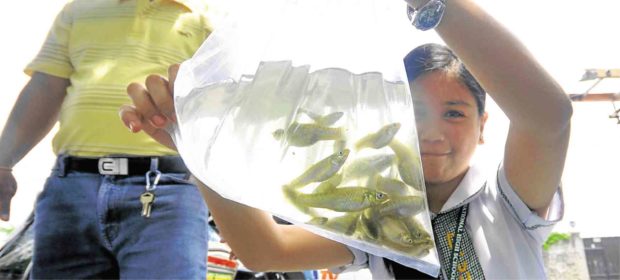BFAR runs out of mosquito fish to fight dengue

FIGHTING DENGUEA student helps release mosquito-eating fish, locally known as “tuyong” and “kataba,” into Dagupan City’s canals and waterways to stop the spread of dengue-carrying mosquitoes. WILLIE LOMIBAO
DAGUPAN CITY—The Bureau of Fisheries and Aquatic Resources (BFAR) here needs fresh supply of mosquito fish, which will be distributed to areas where stagnant water has become the breeding ground for mosquitoes, including carriers of the dengue virus.
BFAR Research Center chief, Westly Rosario, said they could not collect mosquito fish from the fishponds and canals overseen by the center because these were still under high water. He did not say when BFAR could start harvesting more fish.
Dagupan has been enjoying sunshine in the past few days, but it still has to endure more days of flood because of high tide.
About a meter deep of rising water will continue until Sunday, Bernard Cabison, deputy head of the City Disaster Risk Reduction and Management Council, said during a forum on Thursday.
Brace for flood
Article continues after this advertisementThe city government has alerted the affected villages to brace for the floods.
Article continues after this advertisementFloods have been Dagupan’s top problem especially during the rainy season, Cabison said.
The BFAR has received more requests for mosquito fish (Gambusia affinis)—locally known as “tuyong” and “kataba”—due to heavy flooding in this city and some Pangasinan towns where dengue-carrying mosquitoes (Aegis aegypti) thrive.
Biological control
Mosquito fish are effective biological control mechanism against dengue as they are voracious eaters of mosquito larvae, Rosario said.
A single fish, which is only about 4 centimeters long and weighs a gram, can eat a gram or more of mosquito larvae in a day, he said.
Other fish species like tilapia also consume mosquito larvae but not at the rate as tuyong, he said.
The mosquito fish multiply fast and the newly born fish immediately consume larvae, he said.
The Americans introduced mosquito fish to the ecosystem during World War II to control malaria, another mosquito-bred disease.
From January to July 9, the Pangasinan provincial health office recorded 1,942 dengue cases, which were 93.43 percent higher than the number of cases in the same period last year.
Dengue has killed eight patients from the towns of Anda, Binmaley, Asingan and Pozorrubio, and the cities of San Carlos and Urdaneta. —YOLANDA SOTELO